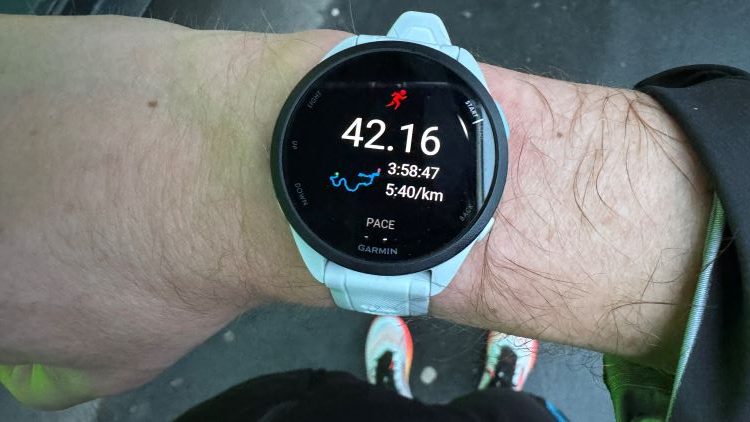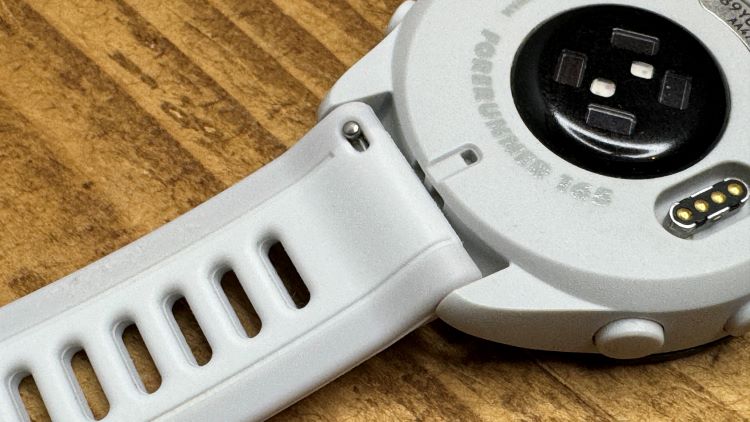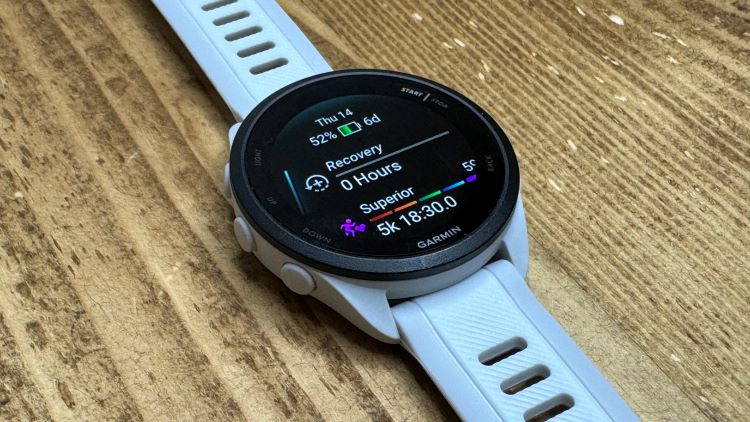Is Garmin’s latest Forerunner the new benchmark for budget running watches? I strapped one on for my marathon training programme…
Garmin has been busy bringing Apple-esque smartwatch screens to running watches. Now the Garmin Forerunner 165 Music is the cheapest dedicated running watch in Garmin’s Forerunner line-up to pack a sharp, bright AMOLED touchscreen. Behind that punchy display it packs a wide range of run-tracking tools targeted at training and racing, along with offline music, contactless payments and 19-hours of GPS runtime. So is this bang-for-buck the best fitness watch you can buy right now? I’ve put it to the test to find out.
Men’s Fitness verdict
The offline music, sleek design and AMOLED display make this Forerunner a sound proposition, but there’s no escaping that lower-than-average battery life.- Excellent bright display
- Compact, comfortable design
- Offline music
- Battery life not class-leading
- Missing some training insights
Why you can trust Men’s Fitness
At Men’s Fitness we pride ourselves on delivering information that serves a singular purpose: to improve some aspect of your health, fitness or wellbeing. For over 16 years, we’ve been publishing authoritative health and fitness content – written by our expert editors and contributors. We spend hours testing every product or service we review, so you can be sure you’re buying the best. This Garmin Forerunner 165 Music was tested by our expert run gear tester Kieran Alger. Find out more about how we test.
I’ve used the Garmin Forerunner 165 Music for two months while training for the Manchester Marathon with Adidas. Along the way I’ve raced a half marathon, 10km, and run a full solo marathon test run.
I compared the Forerunner 165 to the Garmin Forerunner 965, Forerunner 265, COROS Pace 3 and Garmin’s premium watch, the Enduro 2, looking at battery life, GPS and heart rate accuracy, along with the design, features and training insights.
The only difference between the Forerunner 165 and the Forerunner 165 Music is the additional offline music storage, playback and support for streaming services like Spotify and Deezer on the Music edition. So you can link your best running headphones to the watch for phone-free music. The Forerunner 165 Music is also more expensive at £289.99 / $299.99 compared to £249.99 / $249.99 for the non-music option.
Garmin Forerunner 165 Music design
The design and build are pretty basic in terms of materials. It’s a lightweight, plastic-feeling watch. But it’s comfortable and compact, with a disappearing feeling. A good alternative to bulkier running watches that makes it easy to wear 24-7 to unlock the wider sleep, activity and stress insights.
The AMOLED display is obviously the hero and it’s great. It’s bold and bright, snappy and responsive and brings the broad array of training stats and performance graphs to life. A step up from what we’ve been used to in running watch land.
At 1.2 inches, the screen is slightly smaller than the Forerunner 265 (1.3 inches in the 46mm) but there’s plenty of room for your essential mid-run stats. I love the level of customisation Garmin now offers on its running watches. From tweaking which data appears on your screen during workouts to editing your glances – quick links to insights and features – it’s easy to set the watch up to match your needs.
Under the hood, there’s all-systems GPS and Garmin’s Elevate V4 optical heart rate sensor. The quick-release, swappable strap is also fuss free and easy to get a good fit. Overall the watch feels strong and robust.

Garmin Forerunner 165 Music features
The Forerunner 165 drops in between the Forerunner 55 and the Forerunner 265 in Garmin’s running watch line-up. It offers most of the core features you’ll find on the Forerunner 265.
There are some key omissions though. For a start there’s no dual-band GPS or triathlon sports mode. You won’t get all of Garmin’s training insights either. There’s no training status, training load or training readiness readouts. If you want lactate threshold estimates, you’ll need to upgrade, too. But on the whole Garmin has crammed a lot into the Forerunner 165.
It caters for most of what you need to run casually for fitness or train and race up to a marathon. There’s plenty of support if you’re new to running with daily suggested workouts and Garmin Coach adaptive training plans for 5km, 10km, half and marathon. Plus the usual recovery time recommendations.
You can also set a target race and access race-adaptive training recommendations – basically workouts tuned to your race goal but also based on your recent training and response.
Outside of running and training, there’s sleep tracking (including nap detection), morning report, heart rate variability insights and ‘body battery’ energy level estimates.
You can also plan and load routes onto the watch and follow with turn-by-turn directions. There are no maps though.
In addition to the regular smartphone notifications, the Forerunner 165’s smartwatch smarts includes offline music (Music edition only), Garmin Pay contactless payments and WiFi syncing.
Garmin Forerunner 165 Music performance
In my tests, I found the Forerunner 165 GPS and the heart rate accuracy to be surprisingly good. Despite the lack of accuracy-boosting dual-frequency GPS on the Forerunner 165, in my tests against the Forerunner 265, Forerunner 965 and the Enduro 2, the Forerunner held its own. It clocked overall distances well within the margin for error against those other devices and the real-time pacing was on par too.
When you dig into the GPS tracks there are some occasions where the Forerunner 165 deviates slightly but it generally locked my routes with as much reliability as those pricier, dual-frequency watches. That was the case even in the more testing conditions of the Barcelona Half Marathon and the London Winter 10km, which take you through the built-up cities where GPS often struggles.
The optical heart rate performance from Garmin’s Elevate V4 sensor was also relatively reliable. Across steady runs and interval sessions, it tracked well against the optical sensors on the pricier Forerunners and performed OK against the Polar H10 chest strap. The Forerunner 165 is not infallible, but as optical heart rate monitors go, it’s been solid and a decent match for the more expensive Garmins.

Garmin Forerunner 165 Music battery life
While the AMOLED screen is wonderful, you’ll sacrifice battery life for the pleasure. On paper, the 19 hours GPS battery life is shorter than you’ll find on a Forerunner 55 (20hrs), Forerunner 265 (20hrs) or Forerunner 255 (26hrs) and the COROS Pace 3 (38hrs).
Personally I wanted more than the Forerunner 165 offers. In my tests I got between 5-8 days general training usage, with around 5-6 hours GPS run time before I had to put it on charge.
Twice I had to charge after just 5 days and I’m not a particularly heavy user of the watch features between runs. I have notifications off and screen settings tweaked to save power. Also if you use that music, you’ll see the battery drain far quicker. A 1-hour run using music burned 14%.
Without music my 1:25 half marathon burned 11% and the 4-hour marathon burned 21%.
So while the claimed 19-hour GPS run time just about rings true – and that might be enough for many runners – if you train daily, run long regularly or want to make heavy use of the music, that battery life comes up quite short.
Should you buy the Garmin Forerunner 165 Music?
The Garmin Forerunner 165 is another accomplished running watch from Garmin that condenses many of the best bits you find on Garmin’s premium watches into a simpler – and somewhat cheaper – model.
Short-ish battery life aside, when it comes to tracking your runs while you’re running, it’s a close rival for more premium, pricey devices on performance and accuracy. Just in a watch that’s more compact (and plasticky).
The bright screen is effective and if you’ve been hankering after a bright, crisp display but the Forerunner 265 price has put you off, this is definitely an option. But it’s not just about the screen. Behind that there’s a reliable, well-featured watch that offers excellent bang for your buck if you’re mainly concerned about what happens during the run or workout.
Is it the best value Garmin running watch? If you’re happy to forego the AMOLED screen and music, the non-music Forerunner 255 might be a better option with additional training insights, a marginally better battery life and that dual frequency GPS.
Beyond Garmin, I’d also recommend taking a look at the COROS Pace 3. Again there’s no AMOLED screen but you get dual band GPS and a much longer battery life. Plus it offers the same lightweight, fuss-free design.
| Display | Colour AMOLED touchscreen |
| Display resolution | 390 x 390 |
| Display size | 1.2in |
| Connectivity | Bluetooth / WiFi |
| Weight | 39g |
How we test the best fitness watches
I am an ultramarathon runner and professional product tester. I ran with each of these watches for a minimum of four weeks, across a range of distances near my base in West London. I also used them for a month’s worth of strength and aerobic training in the gym and at home.






